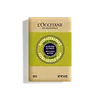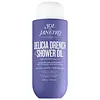What's inside
What's inside
 Key Ingredients
Key Ingredients

 Benefits
Benefits

 Concerns
Concerns

 Ingredients Side-by-side
Ingredients Side-by-side

Helianthus Annuus Seed Oil
EmollientCocos Nucifera Oil
MaskingStearic Acid
CleansingPalmitic Acid
EmollientSodium Hydroxide
BufferingWater
Skin ConditioningButyrospermum Parkii Butter
Skin ConditioningLippia Citriodora Leaf Extract
AstringentSodium Chloride
MaskingCitric Acid
BufferingTetrasodium Glutamate Diacetate
Sodium Benzoate
MaskingParfum
MaskingCitral
PerfumingLimonene
PerfumingLinalool
PerfumingGeraniol
PerfumingHexyl Cinnamal
PerfumingCitronellol
PerfumingHelianthus Annuus Seed Oil, Cocos Nucifera Oil, Stearic Acid, Palmitic Acid, Sodium Hydroxide, Water, Butyrospermum Parkii Butter, Lippia Citriodora Leaf Extract, Sodium Chloride, Citric Acid, Tetrasodium Glutamate Diacetate, Sodium Benzoate, Parfum, Citral, Limonene, Linalool, Geraniol, Hexyl Cinnamal, Citronellol
Glycerin
HumectantWater
Skin ConditioningCocamidopropyl Betaine
CleansingDisodium Cocoamphodiacetate
CleansingParfum
MaskingLactobacillus/Hibiscus Sabdariffa Flower Ferment Filtrate
Skin ConditioningPlatonia Insignis Seed Butter
EmollientCopaifera Officinalis Resin
MaskingPassiflora Edulis Seed Oil
EmollientBertholletia Excelsa Seed Oil
EmollientCocos Nucifera Oil
MaskingEuterpe Oleracea Fruit Oil
Skin ConditioningHelianthus Annuus Seed Oil
EmollientGardenia Jasminoides Fruit Extract
Cosmetic ColorantCarapa Guaianensis Seed Oil
Skin ConditioningPhenoxyethanol
PreservativeSodium Chloride
MaskingPolyquaternium-10
Citric Acid
BufferingHydroxyethylcellulose
Emulsion StabilisingEthylhexylglycerin
Skin ConditioningTetrasodium Glutamate Diacetate
Maltodextrin
AbsorbentSodium Hydroxide
BufferingButylene Glycol
HumectantTocopherol
AntioxidantAlpha-Isomethyl Ionone
PerfumingHydroxycitronellal
PerfumingGlycerin, Water, Cocamidopropyl Betaine, Disodium Cocoamphodiacetate, Parfum, Lactobacillus/Hibiscus Sabdariffa Flower Ferment Filtrate, Platonia Insignis Seed Butter, Copaifera Officinalis Resin, Passiflora Edulis Seed Oil, Bertholletia Excelsa Seed Oil, Cocos Nucifera Oil, Euterpe Oleracea Fruit Oil, Helianthus Annuus Seed Oil, Gardenia Jasminoides Fruit Extract, Carapa Guaianensis Seed Oil, Phenoxyethanol, Sodium Chloride, Polyquaternium-10, Citric Acid, Hydroxyethylcellulose, Ethylhexylglycerin, Tetrasodium Glutamate Diacetate, Maltodextrin, Sodium Hydroxide, Butylene Glycol, Tocopherol, Alpha-Isomethyl Ionone, Hydroxycitronellal
Ingredients Explained
These ingredients are found in both products.
Ingredients higher up in an ingredient list are typically present in a larger amount.
Citric Acid is an alpha hydroxy acid (AHA) naturally found in citrus fruits like oranges, lemons, and limes.
Like other AHAs, citric acid can exfoliate skin by breaking down the bonds that hold dead skin cells together. This helps reveal smoother and brighter skin underneath.
However, this exfoliating effect only happens at high concentrations (20%) which can be hard to find in cosmetic products.
Due to this, citric acid is usually included in small amounts as a pH adjuster. This helps keep products slightly more acidic and compatible with skin's natural pH.
In skincare formulas, citric acid can:
While it can provide some skin benefits, research shows lactic acid and glycolic acid are generally more effective and less irritating exfoliants.
Most citric acid used in skincare today is made by fermenting sugars (usually from molasses). This synthetic version is identical to the natural citrus form but easier to stabilize and use in formulations.
Read more about some other popular AHA's here:
Learn more about Citric AcidCocos Nucifera Oil is obtained from the kernels of the coconut fruit. In other words, this is coconut oil.
Coconut Oil is rich in fatty acids with lauric acid making up the majority of these. It also contains linoleic acid. Due to this high fatty acid content, coconut oil helps trap moisture and soften skin.
Despite being antibacterial, coconut oil may not be great for acne-prone skin. It is comedogenic and may clog pores. This ingredient may not be safe for malassezia or fungal acne.
Note: Coconut Oil should not replace your sunscreen for UV protection. Studies show it only blocks about 20% of UV.
This oil is non-volatile and has a light scent.
The term 'fragrance' is not regulated in many countries. In many cases, it is up to the brand to define this term. For instance, many brands choose to label themselves as "fragrance-free" because they are not using synthetic fragrances. However, their products may still contain ingredients such as essential oils that are considered a fragrance.
Learn more about Cocos Nucifera OilHelianthus Annuus Seed Oil is the oil derived from the seeds of a Sunflower. Sunflower seed oil is non-fragrant. It is an emollient, meaning it helps to soften the skin.
Sunflower seed oil contains many fatty acids. The fatty acids found in sunflower seeds include (from highest amount to least): linoleic acid, myristic acid, palmitic acid, stearic acid, arachidic acid, oleic acid, and linolenic acid.
These fatty acids help the skin create ceramides. Ceramides play a role in repairing the skin barrier.
Helianthus Annuus Seed Oil helps moisturize the skin. This in turn helps the skin look more rejuvenated and smoother.
Sunflowers are rich in vitamin E.
Historians believe Indigenous cultures of North America domesticated sunflowers before corn. Thus they relied on sunflower oil for a variety of uses. One such use is moisturizing skin and hair.
Sunflower seed oil may not be fungal acne safe. We recommend speaking with a professional if you have any concerns.
Learn more about Helianthus Annuus Seed OilParfum is a catch-all term for an ingredient or more that is used to give a scent to products.
Also called "fragrance", this ingredient can be a blend of hundreds of chemicals or plant oils. This means every product with "fragrance" or "parfum" in the ingredients list is a different mixture.
For instance, Habanolide is a proprietary trade name for a specific aroma chemical. When used as a fragrance ingredient in cosmetics, most aroma chemicals fall under the broad labeling category of “FRAGRANCE” or “PARFUM” according to EU and US regulations.
The term 'parfum' or 'fragrance' is not regulated in many countries. In many cases, it is up to the brand to define this term.
For instance, many brands choose to label themselves as "fragrance-free" because they are not using synthetic fragrances. However, their products may still contain ingredients such as essential oils that are considered a fragrance by INCI standards.
One example is Calendula flower extract. Calendula is an essential oil that still imparts a scent or 'fragrance'.
Depending on the blend, the ingredients in the mixture can cause allergies and sensitivities on the skin. Some ingredients that are known EU allergens include linalool and citronellol.
Parfum can also be used to mask or cover an unpleasant scent.
The bottom line is: not all fragrances/parfum/ingredients are created equally. If you are worried about fragrances, we recommend taking a closer look at an ingredient. And of course, we always recommend speaking with a professional.
Learn more about ParfumChances are, you eat sodium chloride every day. Sodium Chloride is also known as table salt.
This ingredient has many purposes in skincare: thickener, emulsifier, and exfoliator.
You'll most likely find this ingredient in cleansers where it is used to create a gel-like texture. As an emulsifier, it also prevents ingredients from separating.
There is much debate on whether this ingredient is comedogenic. The short answer - comedogenic ratings don't tell the whole story. Learn more about comegodenic ratings here.
The concensus about this ingredient causing acne seems to be divided. Research is needed to understand if this ingredient does cause acne.
Scrubs may use salt as the primary exfoliating ingredient.
Learn more about Sodium ChlorideSodium Hydroxide is also known as lye or caustic soda. It is used to adjust the pH of products; many ingredients require a specific pH to be effective.
In small amounts, sodium hydroxide is considered safe to use. However, large amounts may cause chemical burns due to its high alkaline.
Your skin has a natural pH and acid mantle. This acid mantle helps prevent harmful bacteria from breaking through. The acid mantle also helps keep your skin hydrated.
"Alkaline" refers to a high pH level. A low pH level would be considered acidic.
Learn more about Sodium HydroxideTetrasodium Glutamate Diacetate is a chelating agent. Chelating agents help prevent metal ions from binding to other ingredients. This helps prevent unwanted effects and reactions from a product. These metal ions may come from water and are found in miniscule amounts.
Tetrasodium Glutamate Diacetate can also help other preservatives be more effective.
Water. It's the most common cosmetic ingredient of all. You'll usually see it at the top of ingredient lists, meaning that it makes up the largest part of the product.
So why is it so popular? Water most often acts as a solvent - this means that it helps dissolve other ingredients into the formulation.
You'll also recognize water as that liquid we all need to stay alive. If you see this, drink a glass of water. Stay hydrated!
Learn more about Water